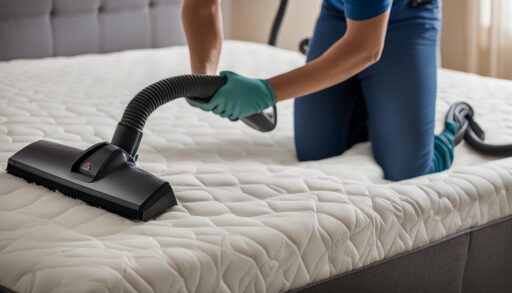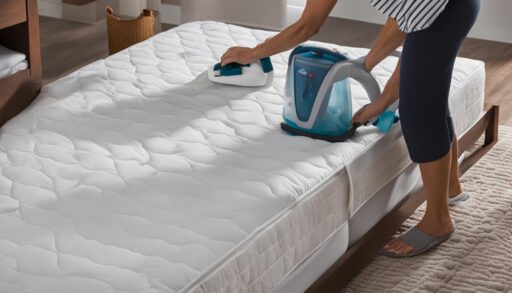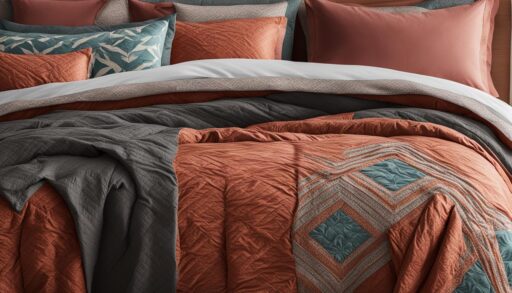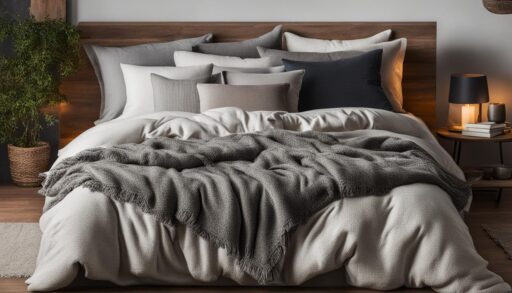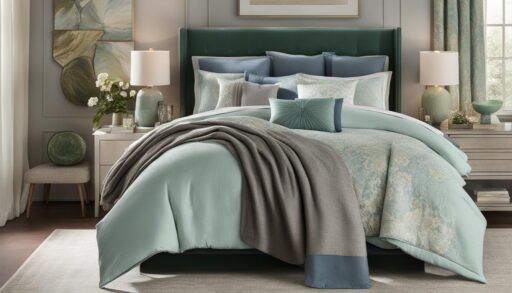Bedroom Bliss: Exploring Bed Materials for Ultimate Comfort and Durability
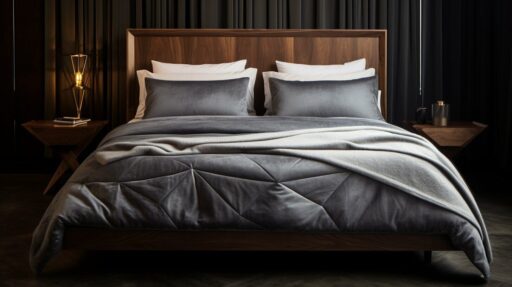
When it comes to creating a comfortable and durable sleeping environment, choosing the right bed materials is crucial. In this comprehensive guide, we will explore different types of bed materials, their properties, and maintenance guidelines to help you make an informed decision. Whether you prefer the plushness of latex or the support of foam, we have you covered with all the information you need.
Key Takeaways:
- Understanding the different types of bed materials is essential for creating a comfortable sleeping environment.
- Consider factors such as durability, comfort, and maintenance when selecting bed materials.
- Latex, foam, hybrid, and natural organic bed materials offer unique properties and benefits.
- Proper maintenance and care can prolong the lifespan of your bed materials.
- Choosing a reputable bed material supplier is important for ensuring high-quality products.
Understanding Latex Bed Materials
Latex is a popular choice for bed materials due to its natural properties and comfort. Latex bed materials are known for their durability, breathability, and pressure-relieving qualities. They are sourced from the sap of rubber trees and processed to create a supportive and resilient material for mattresses. Latex bed materials are available in different firmness options, making them suitable for a wide range of sleepers. The composition of latex bed materials typically includes organic latex, organic cotton, and wool for added comfort and temperature regulation.

One of the key advantages of latex bed materials is their durability. Compared to other mattress materials, latex has a longer lifespan, often lasting over 10 years without significant sagging or wear. This makes it a cost-effective choice for those looking for a long-term investment in their sleep quality.
In addition to its durability, latex bed materials are also highly breathable. The natural open-cell structure of latex allows for better airflow, keeping you cool and comfortable throughout the night. This makes latex an excellent choice for hot sleepers or those who live in warm climates.
Furthermore, latex bed materials excel at pressure relief, contouring to the shape of your body and providing targeted support. This can help alleviate pressure points and promote proper spinal alignment, leading to a more restful and comfortable sleep experience.
Exploring Foam Bed Materials
Foam bed materials, including memory foam and polyurethane foam, are a popular choice for their unique properties and comfort. Memory foam, known for its contouring abilities, conforms to your body shape and provides personalized support, relieving pressure points for a restful sleep. Polyurethane foam, on the other hand, offers a more responsive and supportive feel, promoting proper spinal alignment. These foam bed materials are available in different densities and firmness levels, allowing you to find the perfect balance of comfort and support for your needs.
When it comes to foam bed materials, it’s essential to consider their composition. Memory foam is composed of viscoelastic polyurethane foam, which reacts to your body heat and weight, providing a customized sleeping experience. Polyurethane foam is made from petroleum-based chemicals and offers a combination of durability and comfort. Foam bed materials are widely available from reputable suppliers, ensuring you have a variety of options to choose from when selecting the perfect mattress for your bedroom.
In addition to their contouring and support, foam bed materials have other advantages. They are known for their excellent motion isolation properties, minimizing disturbances caused by a restless sleep partner. Foam also tends to be more hypoallergenic compared to other bed materials, making it a great choice for individuals with allergies or sensitivities. Furthermore, foam bed materials are durable and long-lasting, providing years of comfortable sleep when properly maintained.
“Foam bed materials offer a combination of comfort, support, and durability, making them a top choice for many individuals seeking a good night’s sleep.”
Comparison of Foam Bed Materials
| Material | Properties | Recommended for |
|---|---|---|
| Memory Foam | Contours to the body, relieves pressure points, excellent motion isolation | Side sleepers, individuals with chronic pain or pressure point issues |
| Polyurethane Foam | Responsive and supportive, promotes proper spinal alignment | All sleep positions, individuals who prefer a more supportive feel |
As shown in the table above, memory foam is ideal for side sleepers and those in need of pressure relief, while polyurethane foam offers versatility and support for all sleep positions. Consider your sleeping preferences and needs to determine which foam bed material is the best fit for you.
Discovering Hybrid Bed Materials
When it comes to finding the perfect balance between support and comfort, hybrid bed materials are an excellent option to consider. Combining the benefits of innerspring coils with the cushioning of foam or latex, hybrid mattresses offer a unique sleep experience that caters to a wide range of sleep preferences.
Hybrid bed materials typically consist of a combination of memory foam, latex, and pocketed coils. This combination allows for optimal airflow and temperature regulation while providing just the right amount of support and pressure relief. The coil system in hybrid mattresses provides targeted support, helping to maintain the mattress’s shape and durability over time. The foam or latex layers add an extra layer of cushioning, contouring to your body and promoting a comfortable sleep surface.
Benefits of Hybrid Bed Materials
- Support: The combination of innerspring coils and foam or latex layers offers excellent support for proper spinal alignment.
- Comfort: The foam or latex layers provide a plush and cushioned feel, allowing for pressure relief and enhanced comfort.
- Temperature Regulation: Hybrid bed materials promote airflow, preventing overheating during sleep.
- Motion Isolation: The foam or latex layers help absorb motion, reducing disturbances caused by a restless sleep partner.
- Durability: The coil system in hybrid mattresses adds durability and helps maintain the shape of the mattress over time.
If you’re looking for a mattress that combines the benefits of different materials and offers a balance between support and comfort, hybrid bed materials are worth considering. With their unique composition and various advantages, hybrid mattresses can provide a restful and rejuvenating sleep experience.
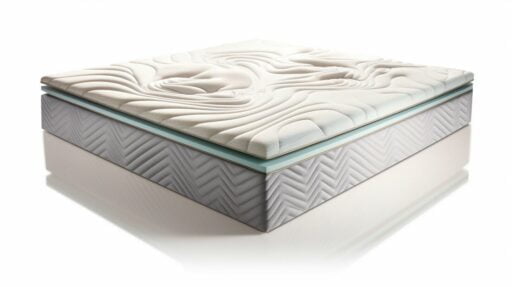
Natural Organic Bed Materials: The Eco-Friendly Choice for Comfortable Sleep
When it comes to creating a healthy and eco-friendly sleeping environment, natural organic bed materials are the way to go. These materials, such as organic latex, organic cotton, and organic wool, offer a chemical-free and sustainable alternative to conventional bedding options. Not only do they provide exceptional comfort, but they also come with a range of benefits for your well-being.
Organic latex is derived from rubber trees and offers excellent breathability, durability, and hypoallergenic properties. It allows for proper airflow and temperature regulation, ensuring a cool and comfortable sleep surface. Organic cotton is known for its softness, moisture-wicking capabilities, and resistance to dust mites and allergens. On the other hand, organic wool provides natural fire resistance and helps regulate body temperature for a cozy and restful sleep.
When choosing natural organic bed materials, it’s important to select reputable suppliers that offer high-quality products. These suppliers prioritize sustainability and ensure that their materials are free from harmful chemicals and pesticides. By opting for natural organic bed materials, you not only invest in your own well-being but also contribute to a healthier planet.

Benefits of Natural Organic Bed Materials:
- Chemical-free and eco-friendly
- Hypoallergenic and resistant to dust mites
- Excellent breathability and temperature regulation
- Durable and long-lasting
- Soft, comfortable, and moisture-wicking
- Naturally fire-resistant
By considering natural organic bed materials for your sleep environment, you can enjoy the comfort and peace of mind that comes with sleeping on environmentally friendly and health-conscious bedding. Take the time to research reputable suppliers and choose materials that align with your values and sleep preferences. With natural organic bed materials, you can create a cozy and sustainable haven for a truly restful night’s sleep.
| Bed Material | Benefits |
|---|---|
| Organic Latex | Breathable, durable, and hypoallergenic |
| Organic Cotton | Soft, moisture-wicking, and resistant to allergens |
| Organic Wool | Natural fire resistance and temperature regulation |
Evaluating Bed Material Durability
When investing in bed materials, durability is an essential factor to consider. You want your mattress to last for years without significant sagging or wear. Let’s take a closer look at the durability of different bed materials, including latex, foam, and hybrids.
Durability of Latex Bed Materials
Latex bed materials are known for their exceptional durability and resilience. They are designed to withstand regular use and maintain their shape over time. With proper care, latex mattresses can last over 10 years without significant deterioration. This makes them a long-lasting investment for a comfortable sleep experience.
Durability of Foam Bed Materials
Foam bed materials, such as memory foam and polyurethane foam, also offer excellent durability. High-density memory foam, in particular, is designed to provide long-lasting support. These materials can withstand the rigors of daily use and retain their shape and comfort for years. Foam mattresses are a popular choice for individuals seeking both durability and pressure relief.
Durability of Hybrid Bed Materials
Hybrid bed materials combine the durability of innerspring coils with the cushioning of foam or latex. The coil system provides targeted support and helps maintain the mattress’s shape over time. The foam or latex layers add extra comfort and pressure relief. Overall, hybrid mattresses are designed to be durable and offer a balance of support and cushioning. With proper care, they can provide long-lasting performance.

As you can see, bed material durability is an important consideration when choosing the right mattress. Whether you opt for latex, foam, or a hybrid, each offers its own level of durability. By selecting a bed material that can withstand regular use and maintain its shape and support, you can enjoy a comfortable and long-lasting sleep surface for years to come.
Maintenance Guidelines for Bed Materials
Proper maintenance is crucial for keeping your bed materials in optimal condition, ensuring their longevity and performance. By following these maintenance guidelines, you can extend the lifespan of your bed materials and enjoy a comfortable sleep environment for years to come.
Cleaning Bed Materials
Regular cleaning is essential to remove dirt, dust, and allergens that can accumulate on your bed materials over time. Here’s how you can clean different types of bed materials:
- Latex Bed Materials: Spot clean with mild detergent and warm water using a soft cloth. Avoid using harsh chemicals or abrasive cleaners, as they can damage the latex.
- Foam Bed Materials: Vacuum the mattress regularly to remove surface dust. Spot clean any stains or spills using a mixture of mild detergent and water. Allow the foam to air dry completely before covering.
- Hybrid Bed Materials: Follow the cleaning instructions provided by the manufacturer, as the cleaning methods may vary depending on the materials used in the construction.
It’s important to address spills or stains on your bed materials promptly to prevent them from seeping into the mattress and causing lingering odors or damage.
Caring for Latex, Foam, and Hybrid Bed Materials
In addition to regular cleaning, here are some general care tips for maintaining different bed materials:
- Latex Bed Materials: Rotate and flip your latex mattress every 3-6 months to distribute wear evenly. This helps prevent sagging and prolongs the lifespan of the mattress.
- Foam Bed Materials: Allow your foam mattress to fully expand after unpacking before using it. This ensures that it reaches its intended shape and provides optimal comfort and support. Avoid placing heavy objects on the foam mattress, as this can cause indentations.
- Hybrid Bed Materials: Check the manufacturer’s guidelines for specific care instructions for your hybrid mattress. Some hybrid mattresses may have removable covers that can be machine washed, while others may require spot cleaning or professional cleaning.
Proper care and maintenance will help your bed materials maintain their shape, support, and comfort over time, allowing you to enjoy a restful sleep every night.
| Bed Material | Cleaning Method | Care Tips |
|---|---|---|
| Latex | Spot clean with mild detergent and warm water | Rotate and flip every 3-6 months |
| Foam | Vacuum regularly and spot clean stains | Allow the foam to fully expand before use |
| Hybrid | Follow manufacturer’s cleaning instructions | Check care guidelines for specific maintenance tips |
Selecting the Right Bed Materials for Your Needs
Choosing the right bed materials is crucial for creating a comfortable and restful sleep environment. When selecting bed materials, there are several factors to consider to ensure that you find the perfect fit for your needs. Here are some important considerations:
Sleep Position and Body Weight
Your sleep position and body weight play a significant role in determining the ideal bed materials for you. Side sleepers may benefit from the contouring and pressure relief provided by memory foam or latex. Back sleepers often find comfort in the support and cushioning of hybrid bed materials. Stomach sleepers typically require firmer bed materials to prevent excessive sinking and maintain proper spinal alignment.
Comfort Preferences
It’s important to consider your personal preferences for firmness and cushioning. Some individuals prefer a softer feel, while others prefer a firmer surface. Memory foam offers a plush, contouring sensation, while latex provides a more responsive and buoyant feel. Hybrid bed materials offer a balanced combination of support and comfort, making them suitable for various comfort preferences.
Durability
Bed material durability is another crucial factor to consider. Latex bed materials are known for their exceptional longevity, often lasting over 10 years without significant sagging or wear. Memory foam and hybrid bed materials with high-density foam layers also offer long-lasting support and comfort. It’s important to choose bed materials that can withstand regular use and maintain their shape and support over time.
Allergies and Sensitivities
If you have allergies or sensitivities, you may want to consider natural organic bed materials. Organic latex, cotton, and wool are often hypoallergenic and free from harmful chemicals and pesticides. These materials provide a healthy and eco-friendly sleeping surface, making them an excellent choice for individuals with allergies or environmental concerns.
By considering these factors and conducting thorough research, you can select the right bed materials that meet your specific needs and preferences. Remember to prioritize comfort, durability, and any unique requirements you may have to create the perfect sleep sanctuary.

Understanding Bed Material Properties
When selecting the perfect bed materials for your sleeping environment, it’s crucial to understand the unique properties they offer. This understanding will help you choose the best option that suits your needs and preferences. Let’s delve into the key properties of bed materials:
1. Breathability
A bed material’s breathability refers to its ability to allow air to flow freely through it. This property plays a vital role in regulating your body temperature while you sleep. Latex bed materials are known for their excellent breathability, providing a cool and comfortable sleep surface. This can be especially beneficial for individuals who tend to sleep hot or live in warmer climates.
2. Pressure Relief
Pressure relief is a crucial property for comfortable sleep. Bed materials that offer good pressure relief contour to your body, relieving pressure points and distributing weight evenly. Memory foam bed materials excel in providing exceptional pressure relief by molding to your body shape, promoting better spinal alignment, and minimizing pain in sensitive areas such as shoulders and hips.
3. Motion Isolation
If you share your bed with a restless sleeper or are easily disturbed by movements during sleep, motion isolation is an important property to consider. Foam bed materials, such as memory foam, are renowned for their superior motion isolation capabilities. They absorb and minimize the transfer of motion, reducing disturbances caused by your partner’s movements, resulting in a more restful sleep.
4. Temperature Regulation
Temperature regulation is essential for a comfortable sleep environment, and bed materials that offer this property can greatly enhance your sleep quality. Hybrid bed materials, with their combination of supportive coils and cushioning foam or latex, promote optimal airflow, allowing heat to dissipate effectively. This helps regulate your body temperature throughout the night, ensuring a comfortable sleep experience.
Understanding the properties of bed materials, such as breathability, pressure relief, motion isolation, and temperature regulation, allows you to make an informed decision when selecting the right bed materials for your needs. Consider your personal preferences and sleep requirements to find the perfect combination of properties that will provide the ultimate comfort and support for a restful night’s sleep.

Exploring Bed Material Suppliers
When it comes to choosing the right bed materials, finding a reputable supplier is essential. You want to ensure that you’re getting high-quality products that offer both comfort and durability. One industry-leading bed material supplier that stands out is PlushBeds. They are known for their wide range of organic and eco-friendly options, including latex, foam, and hybrid mattresses.
PlushBeds prioritizes sustainability, using natural materials that are free from harmful chemicals. Their organic latex mattresses are made from pure latex derived from rubber trees, providing excellent breathability, durability, and hypoallergenic properties. They also offer organic cotton and wool options, which add softness, moisture-wicking capabilities, and natural fire resistance to their mattresses.
As a reputable bed material supplier, PlushBeds has garnered positive reviews from numerous customers. Their commitment to quality and customer satisfaction sets them apart. If you’re looking for premium bed materials that are both comfortable and eco-friendly, exploring PlushBeds’ products should be on your list.
The Advantages of Choosing PlushBeds:
- Wide range of organic and eco-friendly options
- High-quality materials and craftsmanship
- Excellent breathability, durability, and hypoallergenic properties
- Positive customer reviews and reputation
Table: A Comparison of Reputable Bed Material Suppliers
| Supplier | Specialization | Product Range | Materials | Customer Reviews |
|---|---|---|---|---|
| PlushBeds | Organic and eco-friendly options | Latex, foam, and hybrid mattresses | Organic latex, cotton, and wool | Positive |
| Company X | Innerspring mattresses | Traditional and hybrid mattresses | Coils, foam, and latex | Mixed |
| Company Y | Memory foam mattresses | Memory foam mattresses and toppers | Memory foam | Positive |
When comparing reputable bed material suppliers, it’s important to consider specialization, product range, materials used, and customer reviews. PlushBeds offers a wide selection of organic and eco-friendly options, and their materials are known for their comfort, durability, and hypoallergenic properties. Positive customer reviews further validate the quality of their products. Take the time to research and compare different suppliers to find the one that best meets your specific needs and preferences.
By selecting a reputable bed material supplier like PlushBeds, you can have peace of mind knowing that you’re making a wise investment in your sleep quality and overall well-being.
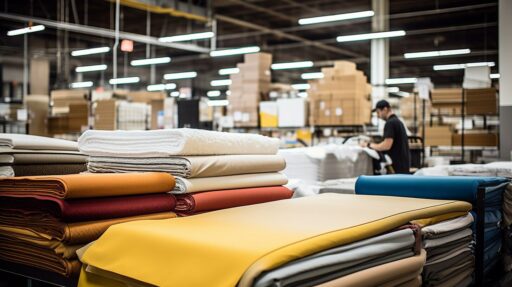
Guidelines for Choosing Bed Materials
When it comes to selecting the right bed materials for your needs, considering various factors can help ensure a comfortable and restful sleep experience. Here are some essential guidelines and tips to keep in mind:
1. Consider Your Sleep Position and Body Weight
Take into account your preferred sleep position and body weight when choosing bed materials. Side sleepers may benefit from the contouring and pressure relief of memory foam or latex. Back sleepers may require a balance of support and comfort provided by hybrid bed materials. Stomach sleepers typically benefit from firmer bed materials that prevent excessive sinking.
2. Determine Your Comfort Preferences
Assess your comfort preferences in terms of firmness and cushioning. Some individuals prefer a softer, plush feel, while others require a firmer sleeping surface. Consider your personal comfort needs and test out different bed materials to find the one that provides the right amount of support and cushioning for you.
3. Evaluate Bed Material Durability
Ensure the bed materials you choose are durable and long-lasting. Latex bed materials are known for their exceptional durability and resilience, while high-density foam can also provide long-lasting support. Hybrid bed materials, which combine innerspring coils with foam or latex, offer a balance of durability and comfort. Consider the lifespan of the materials and choose those that can withstand regular use without sagging or wear.
4. Take Allergies or Sensitivities into Account
If you have allergies or sensitivities, consider bed materials that are hypoallergenic and free from harmful chemicals. Natural organic bed materials, such as organic latex and organic cotton, can provide a chemical-free and eco-friendly sleeping surface. These materials are known for their breathability, hypoallergenic properties, and resistance to dust mites and allergens.
5. Research and Compare Bed Material Suppliers
Take the time to research reputable bed material suppliers and compare their offerings. Look for suppliers that prioritize quality, sustainability, and customer satisfaction. Read customer reviews and consider factors such as product warranties, return policies, and overall reputation. Choosing a reliable supplier can ensure you get high-quality bed materials and excellent customer service.
By following these guidelines and considering your individual needs and preferences, you can select the right bed materials that provide the perfect blend of comfort and durability for a restful night’s sleep.
Conclusion
In conclusion, selecting the right bed materials is essential for optimizing comfort and durability in your bedroom. Whether you prefer the plushness of latex, the contouring of foam, or the support of hybrids, understanding the properties and maintenance requirements of different bed materials is crucial.
By considering factors such as your sleep position, body weight, and personal comfort preferences, you can choose bed materials that provide the right level of support and cushioning. Additionally, evaluating the durability of the bed materials ensures that your investment will last for years to come.
Furthermore, it’s important to choose bed material suppliers wisely. Reputable brands like PlushBeds prioritize sustainability, comfort, and durability, making them a top choice for many individuals seeking high-quality bed materials.
By following proper maintenance guidelines, such as regular rotation and spot cleaning, you can prolong the lifespan of your bed materials and maintain their performance over time. With the right bed materials and proper care, you can create a bedroom that offers the perfect balance of comfort and durability for a restful night’s sleep. Sweet dreams!
FAQ
What are the properties of latex bed materials?
Latex bed materials are known for their durability, breathability, and pressure-relieving qualities. They are sourced from the sap of rubber trees and processed to create a supportive and resilient material for mattresses. The composition of latex bed materials typically includes organic latex, organic cotton, and wool for added comfort and temperature regulation.
What are the properties of foam bed materials?
Foam bed materials, such as memory foam and polyurethane foam, are known for their contouring and pressure-relieving properties. Memory foam molds to the shape of your body, providing personalized support and reducing pressure points. Polyurethane foam offers a more responsive and supportive feel. Foam bed materials are available in different densities and firmness levels, allowing for customized comfort. They are also known for their motion isolation capabilities.
What are hybrid bed materials?
Hybrid bed materials combine the support of innerspring coils with the comfort and pressure relief of foam or latex. The coil system provides targeted support and helps maintain the mattress’s shape, while the foam or latex layers add cushioning and contouring. Hybrid bed materials often include a combination of memory foam, latex, and pocketed coils.
What are natural organic bed materials?
Natural organic bed materials offer a chemical-free and eco-friendly sleeping surface. Organic latex, derived from rubber trees, is a popular choice due to its breathability, durability, and hypoallergenic properties. Organic cotton is known for its softness and moisture-wicking capabilities, while organic wool provides temperature regulation and natural fire resistance.
How long do latex bed materials last?
Latex bed materials are known for their exceptional durability and resilience, often lasting over 10 years without significant sagging or wear.
How should I maintain my bed materials?
For latex bed materials, regular rotation and flipping can help distribute wear evenly. Spot cleaning with mild detergent and warm water is recommended for cleaning latex. Foam bed materials should be regularly aired out and spot cleaned as necessary. Hybrid bed materials may require more frequent rotation and occasional cleaning of the mattress cover. Following the manufacturer’s care instructions is crucial to ensure the longevity and performance of your bed materials.
What factors should I consider when selecting bed materials?
When selecting bed materials, consider factors such as your preferred sleep position, body weight, and personal comfort preferences. It’s also important to consider any allergies or sensitivities you may have.
What are the unique properties of different bed materials?
Latex bed materials provide breathability and a cool sleep surface. Foam bed materials excel at pressure relief and motion isolation. Hybrid bed materials offer a combination of support and comfort while promoting airflow for temperature regulation.
Where can I find reputable bed material suppliers?
PlushBeds is an industry-leading bed material supplier known for their organic and eco-friendly options, including latex, foam, and hybrid mattresses.
What guidelines should I follow when choosing bed materials?
Consider your sleep position and body weight, determine your comfort preferences for firmness and cushioning, evaluate the durability of the bed materials, take into account any allergies or sensitivities, and research and compare different bed material suppliers.

